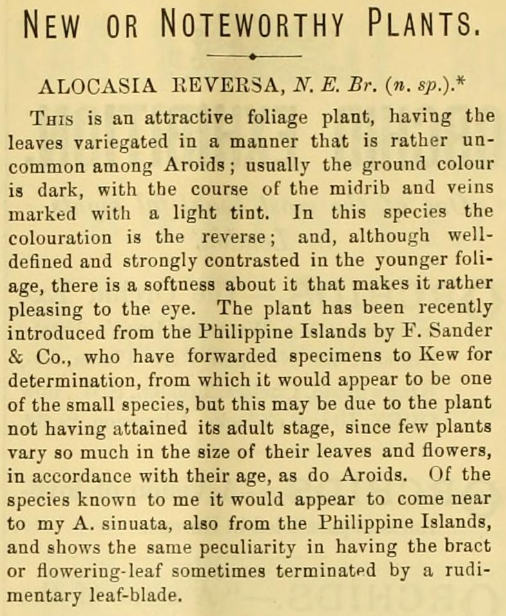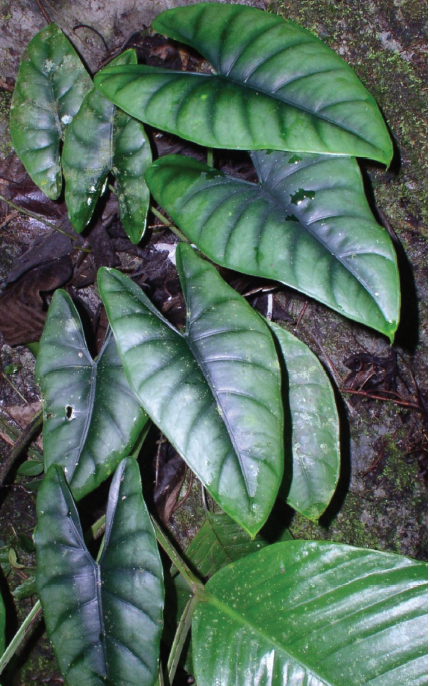ALOCASIA REVERSA
SYNONYMS: Alocasia 'Hana' (known under this name in Singapore), Alocasia ‘Blue Cuprea’ (known under this name in Australia in the 1980s according to Burnett (1984), Alocasia porphyroneura (incorrectly described as such, an accepted synonym for Alocasia princeps)
DISTRIBUTION: Borneo, native to Sarawak (specifically the district of Padawan)
CLIMATE: Tropical humid climate
Humidity is moderate throughout the year, ranging from 60% to 70%
Temperature is varies between the seasons - within the range of 48°F/9°C to 88°F/31°C during the day. Minimum temperatures never dip below 45°F/7°C
Rainy and humid season (October to May) and a dry season between June and October. The average annual rainfall is 1,200 mm
ECOLOGY: In forest over limestone, often on boulders, to 300 m altitude.
SPECIES DESCRIPTION:
Small herb to ca. 35 cm tall (often less); rhizome short, condensed, erect to decumbent, ca. 3 cm diam.; leaves several together, irregularly interspersed with marcescent brown lanceolate cataphylls to ca. 7 cm long; petioles ca. 10-20(-30) cm long, sheathing in the lower ca. 10-15%; blades thinly leathery, in adult plants all peltate or (usually) mixed peltate and nonpeltate, occasionally none peltate, ovate to rather narrowly ovato-sagittate, 14 X 6 cm to 22 x 10 cm, widest at or slightly distal to junction of petiole, glossy dark green about the midrib and primary veins adaxially, the rest grey-green; anterior lobe acute, with the tip abruptly acuminate for ca. 1 cm; anterior costa with 3-4(-5) primary lateral veins on each side, diverging at ca. 90° proximally, the distal ones at ca. 60°, running almost straight to the margin and joining a submarginal vein; axillary glands not conspicuous; secondary venation fine, not forming interprimary collective veins, or these very poorly defined, flush with the lamina; posterior lobes about V2-2/5 the length of the anterior, united for 50-90% of their length or free, when maximally united the base of the lamina rounded except for an acute notch; posterior costae diverging at ca 15° when blade peltate, or at ca. 90° when not peltate but then soon curved back (so posterior lobes not widely divergent) and naked in the sinus for ca. 1 cm
INFLORESCENCE:
Inflorescences 1-2 together, subtended by lanceolate marcescent brown cataphylls; peduncle ca. 10 cm long at anthesis, often exceeding the petioles at fruiting; spathe ca. 6 cm long: lower spathe ca. 2 cm long, ovoid, pale green; limb paler green to ivory edged purple with the colour extending into the constriction ventrally, at first erect, then sharply deflected, oblong lanceolate, mucronate for ca. 6 mm; spadix somewhat shorter than the spathe, white except for bright green ovaries, stipitate for ca. 3 mm; female zone 1 cm long; pistils somewhat loosely packed, flask-shaped, ca. 1.5 mm diam., facing obhquely upwards; style slender, ca. 0.5 mm long; stigma 2-lobed; sterile interstice ca. 4 mm long, not much attenuated and situated within the chamber of the lower spathe, lower synandrodia irregular in shape, ca. 2 mm diam., upper ones rhombo-hexagonal; male zone ca. 1 cm long, 4 mm diam., subcylindric, slightly constricted ca 2/3 from the base corresponding to spathe constriction; synandria rhombo-hexagonal ca. 2 mm diam., 4-6-merous, the thecae opening by apical pores, synconnective not expanded; appendix about isodiametric with male zone, ca. 2 cm long, gradually tapering to a blunt point, faintly longitudinally channelled; fruiting spathe broadly ovoid, ca. 2 cm long, eventually reflexed, pinkish to orange; berries bright orange to red.
VARIEGATED FORMS: N/A
ETYMOLOGY: The specific epithet reversa pertains to the unique variegation seen in this species, which is a reverse of what is traditionally seen: the midrib and veins are marked with a light tint
NOTES:
1 . This species, first described from cultivation in Britain following introduction by Sander & Sons, was originally attributed to the Philippines and consequently cited by some later authors as a Philippine plant. No authentically Philippine material of this species has been found however, and it must be assumed that Sander's attribution was a mistake, or deliberately misleading - a practice, according to Burnett (1984), of competing nurserymen of the time.
2. This and the following species appear in their inflorescence structure to belong in the Scabriuscula Group. They differ in their (usually) peltate leaves and the frequent (but ?irregular) cataphylls among the fohage leaves, which suggests relationship with the Cuprea Group.
Other specimens seen: SARAWAK: Kuching Distr., Tiang Bekap, Padawan Rd, Anderson 10095 (K, L, SING); Cult. RBG Edinburgh Acc. no. 67.1612 ex Bukit Serapat, ca. 13 mi from Kuching on Semenggang Rd, Burn & Martin 4745 (E); Kuching Distr., Tiang Bekap, Mt Mentawa, Chew 670 (GH, K, L, SING), 1292 (GH, K, SING); Along Kuching-Padawan Rd, 10 mi SW of main Kuching-Serian Highway, Croat 53183 (MO); Bukit Manok, Padawan, 38 mi from Kuching, Erwin & Paul S.27408 (K, US); Zuab (CHECK), Hewitt s.n. (K); Bidi, Hewitt 4 (SING); Bukit Mentawa off 32nd Mile Padawan Rd, Kuching, 1st Div., Mamit S.32673 (K, L, SING, US); Gat, 'Native Collector' D106 (E); Cult. RBG Sydney Acc. no. 942723 ex cult. Hort. Leiden Acc. no. 933071 ex N of Padawan, Vogel s.n. (NSW); Bukit Payang, 10 km Tebakang-Tebedo Rd, 1st Div., Yii & Othman S.46241 (K, KEP).
CULTIVARS: N/A
HYBRIDS: Alocasia ‘Green Bold’ (Alocasia reversa x Alocasia melo), Alocasia ‘Tyaga’ (Alocasia reginae x Alocasia reversa)





















